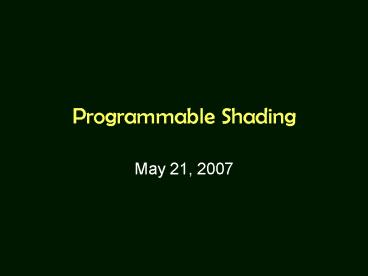Programmable Shading - PowerPoint PPT Presentation
Title: Programmable Shading
1
Programmable Shading
- May 21, 2007
2
Motivation
- Recall what are done in the graphics pipeline
- Front End Transformations (Modeling, Viewing,
and Projection) and Lighting. - Back End Rasterization and Interpolations (of
Colors, Depth, and Texture Coordinates) - What are their input/output parameters?
3
OpenGLFixed Function Vertex
Vertex (object)
Vertex (clip)
TransformMVP,MV,MV-T
Normal
Vertex (eye)
ColorSecondaryColor
FrontBackColor
0,1
Lighting
FrontBackSecondaryColor
0,1
Texgen
TextureMatrixn
TexCoordn
TexCoordn
EdgeFlag
EdgeFlag
4
OpenGLFixed Function Fragment
Color
SecondaryColor
Texn
TEn
Sum
Fog
Color
TexCoordn
0,1
z (ze,f )
Depth
Depth
Coord
Coord
FrontFacing
FrontFacing
5
Programmable Shading
- Why not doing something different with those
input? - Case in focus bump mapping
- Bump mapping simulates detail with a surface
normal that varies across a surface.
6
(No Transcript)
7
RenderMan Its Shading Language
8
Key Idea of a Shading Language
- Image synthesis can be divided into two basic
concerns - Shape Geometric Objects, Coordinates,
Transformations, Hidden-Surface Methods - Shading Light, Surface, Material, Texture,
- Control shading not only by adjusting parameters
and options, but by telling the shader what you
want it to do directly in the form of a procedure
9
Pixars RenderMan
- Separation of Modeling and Rendering
- RenderMan serves as the interface.
- Scene Shape Shading
- The power of RenderMan is in the shading part.
10
Example 1
include ltri.hgt RtPoint Square4.5,.5,.5,.5,
-.5,.5, -.5,-.5,.5,-.5,.5,.5 Main() R
iBegin(RI_NULL) RiWorldBegin() RiSurface(con
stant, RI_NULL) RiPolygon(4, RI_P,
(RtPointer)Square, RI_NULL) RiWorldEnd() RiEnd
()
11
Example 2
- Colorspheres.c in the BMRT/examples folder.
12
Building and Running
- Must have the following
- Header file ri.h
- Link library
- A renderer
- The program generates a RenderMan Interface
file, but doesnt render it - So that you may pick a renderer that matches the
graphics power of your machine.
13
Pixars RenderMan
14
Comparison to OpenGL
- It doesnt do the actual rendering.
- Separation of modeling and rendering.
- Its the task of the renderer.
- RiSurface() changes the graphics state
- Similar to glColor()
- RiPolygon() to describe the models
- Similar to glBegin(GL_POLYGON)
15
RenderMan Interface Spec
- Where do you find the meaning of the arguments to
those Ri() functions? - Check the spec! (available directly from Pixar).
- Appendix G contains a quick reference.
- http//www.pixar.com/renderman/developers_corner/r
ispec/rispec_pdf/RISpec3_2.pdf
16
BMRT
- A public-domain implementation of Pixar
Photorealistic RenderMan (PRMan). - Three main components
- Rendrib the renderer
- Rgl quick rendering for preview
- Slc shading language compiler
17
Shading Language
- Many types of shaders are possible
- Light source shaders
- Surface shaders
- Atmosphere shaders
- Volume shadersetc.
- We will discuss only the surface shaders.
18
Shader Writing
- Global variables (from Table 14.2 of The
RenderMan Companion book) - Camera position, surface color/opacity, surface
position/normal, texture coordinatesetc. - Must output color of light from surface, opacity
of surface. - Many built-in operators (Table 14.4) and
functions (Ch.15, Tables 15.1-15.2).
19
Example Plastic Surface
- surface
- plastic (float Ka 1, Kd 0.5, Ks 0.5,
roughness 0.1 - color specularcolor 1)
- normal Nf faceforward (normalize(N),I)
- Ci Cs (Kaambient() Kddiffuse(Nf))
- specularcolor
- Ksspecular(Nf,-normalize(I),roughness)
- Oi Os Ci Oi
20
RenderMans Shader
- Phong shader
surface phong( float Ka 1, Kd 1, Ks
0.5 float roughness 0.1 color
specularcolor 1 ) normal Nf
faceforward( normalize(N), I ) vector V
-normalize(I) color C 0 illuminance( P
) vector R 2normalize(N)
(normalize(N) . normalize( L )) -
normalize( L ) C KaCs
KdCs( normalize(N) . normalize(L) )
Ksspecularcolor pow(( R . V ), 10)
Ci CCs
21
Shading Languages for Graphics Hardware
22
(No Transcript)
23
Bump Map Example
- Bump mapping simulates detail with a surface
normal that varies across a surface
24
(No Transcript)
25
RenderMan Example
displacement lumpy ( float Km 1, frequency 1,
maxoctaves 6 string shadingspace
"shader" float truedisp 1)
point Pshad transform (shadingspace,
frequencyP) float dPshad
filterwidthp(Pshad) float magnitude fBm
(Pshad, dPshad, maxoctaves, 2, 0.5) N
Displace (normalize(N), shadingspace,
Kmmagnitude, truedisp)
26
Cg Example
f2fb DiffuseBumpPS(v2f IN, uniform sampler2D
DiffuseMap, uniform sampler2D NormalMap,
uniform float4 bumpHeight) f2fb OUT float4
color tex2D(DiffuseMap) //fetch base
color //fetch bump normal float4 bumpNormal
expand(tex2D(NormalMap)) bumpHeight //expand
iterated light vector to -1,1 float4
lightVector expand(passthrough(IN.LightVector))
//compute final color (diffuse
ambient) float4 bump uclamp(dot3_rgba(bumpNorma
l.xyz, lightVector.xyz)) OUT.col color
bump return OUT
27
(No Transcript)
28
GL2 Logical Diagram
29
OpenGLFixed Function Vertex
Vertex (object)
Vertex (clip)
TransformMVP,MV,MV-T
Normal
Vertex (eye)
ColorSecondaryColor
FrontBackColor
0,1
Lighting
FrontBackSecondaryColor
0,1
Texgen
TextureMatrixn
TexCoordn
TexCoordn
EdgeFlag
EdgeFlag
30
GL2 Vertex Processor
Vertex (object)
Vertex (clip)
Uniform
Normal
Vertex (eye)
ColorSecondaryColor
VertexShader
FrontBackColor
FrontBackSecondaryColor
Temporaries
TexCoordn
TexCoordn
EdgeFlag
EdgeFlag
31
OpenGLFixed Function Fragment
Color
SecondaryColor
Texn
TEn
Sum
Fog
Color
TexCoordn
0,1
z (ze,f )
Depth
Depth
Coord
Coord
FrontFacing
FrontFacing
32
GL2 Fragment Processor
Color
Uniform
Texture
SecondaryColor
FragmentShader
TexCoordn
Color
z (ze,f )
Depth
Depth
Temporaries
Coord
Coord
FrontFacing
FrontFacing
33
Comparison































